#140: Morchella angusticeps, the Black Morel of Eastern North America
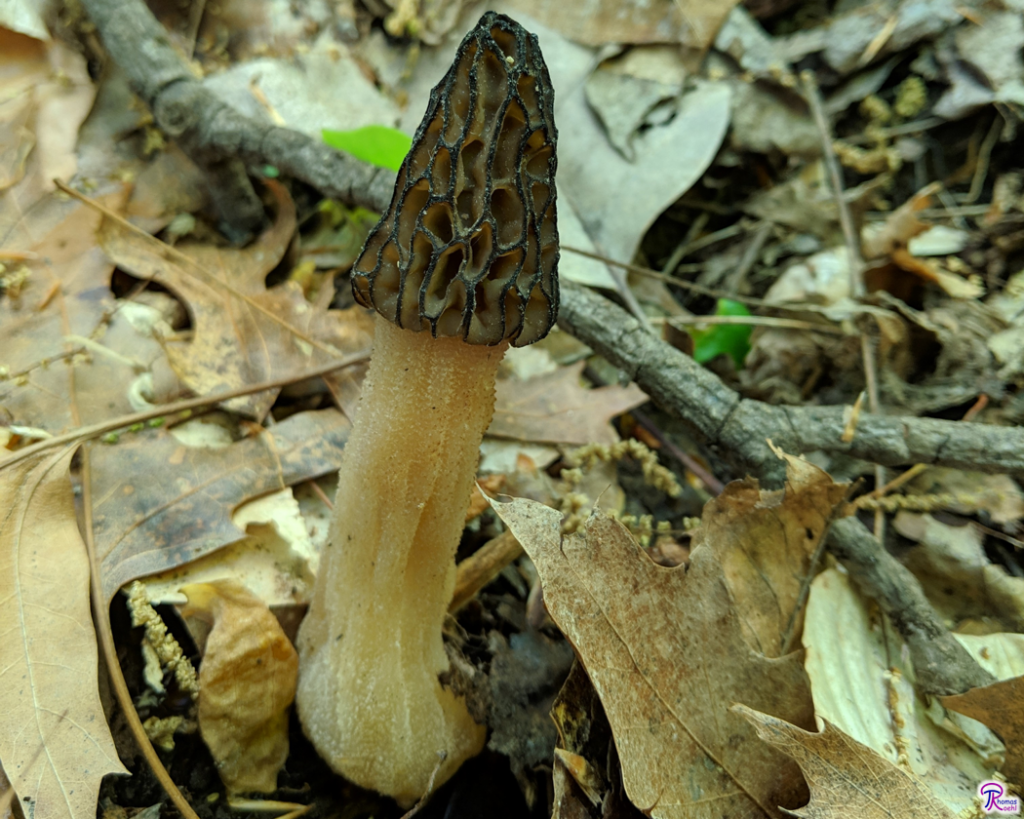
Black morels can be distinguished from yellow morels by their dark ridges and light pits. Other morels have light ridges with darker (or only slightly darker) pits. Morchella angusticeps is the most widespread black morel in North America. It can be found almost anywhere east of the Rocky Mountains, although it is not as common as yellow morels (see FFF#086 and FFF#226). There are a handful of black morel species, but you can easily identify M. angusticeps because it is the only one in eastern North America that does not grow in burn sites or on wood.1,2
Description
For those of you not familiar with morels, here is a short refresher on what a morel looks like. The closest thing to which I can liken a morel is a sea sponge on a pedestal. Morels are made up of two sections: a head and a stipe. The stipe can be lobed but is generally straight and holds up the head in a roughly vertical orientation. The head is conic to oval (depending on the species) and is characterized by a network of irregularly-shaped ridges and pits. Although they are irregular, the ridges and pits are well-defined, unlike most false morels (FFF#034), which have smaller “ridges” that are more like wrinkles. Additionally, morels have a single hollow cavity that extends from the base of the stipe to the tip of the head while false morels have stipes that are solid or chambered and verpas (FFF#067) have stipes filled with cottony material. False morels and verpas also have heads that attach only at the tip of the stipe, but true morels have heads that attach to the stipe for their full length or at least half their length.2,3
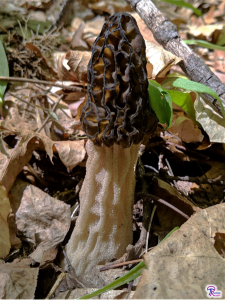
How can you distinguish black morels from yellow morels? Simple: the edges of the ridges are darker than the pits. For Morchella angusticeps, the ridges start out brown or tan and darken to dark brown or nearly black while the pits start out yellowish brown and largely retain that color as the mushroom ages. For most of its range, this is enough information to separate it from other morels. If you want to be absolutely certain, there are other features you can check.1,2
M. angusticeps is one of the larger morels, growing 5-18cm tall and 2-6cm wide. Its head grows 2.5-9cm tall and is the widest part of the mushroom. It is roughly conical, though it may be flattened at the top and curved in at the bottom to be more egg-shaped. Most of its pits are elongated in a vertical direction, which sets it apart from the haphazardly arranged pits of large yellow morels. The base of the head hangs down over the stipe slightly to make a small but noticeable groove, another feature not found in yellow morels.1,2
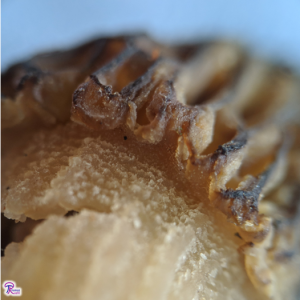
The stipe grows 2-10cm tall and only 1-4cm wide. It is usually the same thickness all the way down, but the base of the stipe can be slightly enlarged. The stipe is yellow brown to tan to pale brown, which makes it roughly the same color as the bottom of the head’s pits. In texture, it is mostly smooth but slightly bumpy or grainy and may develop long furrows, especially in wet weather.1,2
Ecology
M. angusticeps grows in North America east of the Rocky Mountains under various hardwoods. This black morel fruits from the forest floor under tulip trees, white ash, and green ash and less often under cherry trees, pine trees, and poplars. Like other morels, M. angusticeps is probably saprobic and mycorrhizal with these trees during different parts of its life cycle. You can find the mushrooms from March through May, usually somewhat before the yellow morels.1,2 The exact timing depends on weather. In my area in 2019, it remained cool through mid-April and got warm quickly so morel season was condensed into about a two-week period at the end of April and all the morel species fruited at the same time (this was impressive, it’s not often you find M. angusticeps, M. punctipes, M. americana, and M. diminutiva on the same day!). I find that M. angusticeps tends to fruit singly or scattered over a wide area (one mushroom every five meters or so), so when you find one make sure to search for more in a wide nearby area.
Similar Species
There is one other black morel in this part of the world which may be confused with M. angusticeps. If you found your black morel near or above 44° latitude, it could also be M. septentrionalis. The two mushrooms are nearly impossible to tell apart. M. septentrionalis grows 4-7.5cm tall, making it slightly shorter than M. angusticeps. It also has a preference for fruiting near or directly from wood. Additionally, M. septentrionalis has spores that are 20-25 x 11-15µ in size, which makes them slightly smaller than the 22-28 x 11-15µ spores of M. angusticeps.2,4
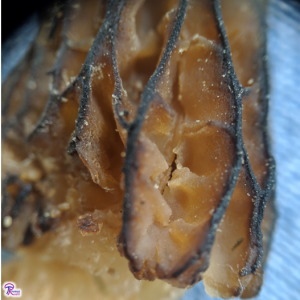
If you found your black morels in a forest that was burned recently (usually within one or two years), you have another species of black morel. These burn site black morels are more difficult to identify to species.3
If your black morels were growing in wood chips, they might be M. elata. This is a European species, but it also appears in mulch or landscaping in other areas of the world.2
You could also confuse M. angusticeps with M. punctipes, the Half-Free Morel (FFF#211). Both species have a similar coloration and texture, but M. punctipes is distinguished by its head, which is small in relation to its stipe and is hangs down over the stipe like a skirt for about half its length (thus the name “Half-Free Morel”).2
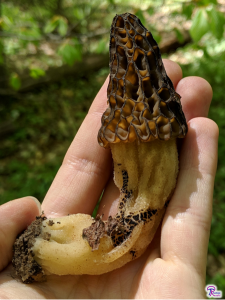
Edibility
Like other morels, M. angusticeps is a choice edible. However, all morels must be thoroughly cooked before being eaten. Raw morels contain toxins that will make you sick but which are destroyed by the cooking process. Some people find that even cooked morels cause mild stomach upset, particularly if they drink alcohol with their morel meal. M. angusticeps seems more likely than most morels to cause stomach upset with alcohol.2 Everyone has different reactions to mushrooms, so whenever you try a new mushroom eat just a little bit first to gauge your personal reaction.
Taxonomy
M. angusticeps used to be called M. elata, but mycologists determined that M. elata was a strictly European species. Older field guides may still call the eastern North American morels M. elata.
| Kingdom | Fungi |
| Subkingdom | Dikarya |
| Division | Ascomycota |
| Subdivision | Pezizomycotina |
| Class | Pezizomycetes |
| Subclass | Pezizomycetidae |
| Order | Pezizales |
| Family | Morchellaceae |
| Genus | Morchella |
| Species | Morchella angusticeps Peck5 |
This post is not part of a key and therefore does not contain enough information to positively identify any mushroom. When collecting for the table, always use a local field guide to identify your mushrooms down to species. If you need a quality, free field guide to North American mushrooms, I recommend Michael Kuo’s MushroomExpert.com. Remember: when in doubt, throw it out!
See Further:
http://www.mushroomexpert.com/morchella_angusticeps.html http://www.midwestmycology.org/Mushrooms/Species%20listed/Morel%20species.html http://www.mushroomexpert.com/morchella_septentrionalis.htmlCitations
- Kuo, M. Morchella angusticeps. MushroomExpert.Com (2012). Available at: http://www.mushroomexpert.com/morchella_angusticeps.html. (Accessed: 3rd May 2019)
- Beug, M. W., Bessette, A. & Bessette, A. R. Ascomycete fungi of North America: a mushroom reference guide. (2014).
- Kuo, M. The Morchellaceae: True Morels and Verpas. MushroomExpert.Com (2012). Available at: http://www.mushroomexpert.com/morchellaceae.html. (Accessed: 3rd May 2019)
- Kuo, M. Morchella septentrionalis. MushroomExpert.Com (2012). Available at: http://www.mushroomexpert.com/morchella_septentrionalis.html . (Accessed: 3rd May 2019)
- Morchella angusticeps. Mycobank Available at: http://www.mycobank.org/MB/189322″>. (Accessed: 3rd May 2019)

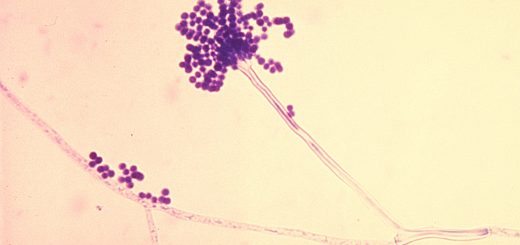
![#007: Omphalotus illudens, the Jack-O-Lantern Mushroom [Archived]](https://www.fungusfactfriday.com/wp-content/themes/hueman/assets/front/img/thumb-medium-empty.png)
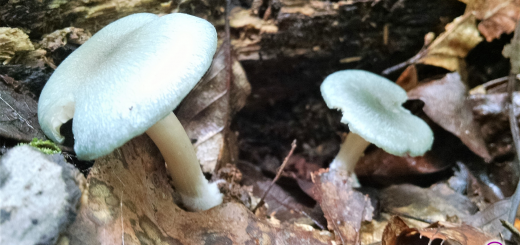





![#011: Characteristics of Kingdom Fungi [Archived]](https://www.fungusfactfriday.com/wp-content/themes/hueman/assets/front/img/thumb-small-empty.png)

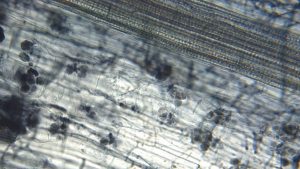
2 Responses
[…] these features to help you identify edible morel mushrooms, the black morel (Morchella elata & M. angusticeps) and the morel (Morchella […]
[…] https://www.fungusfactfriday.com/140-morchella-angusticeps/ […]